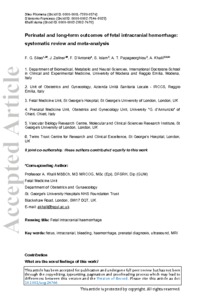Sileo, FG; Zöllner, J; D'Antonio, F; Islam, S; Papageorghiou, AT; Khalil, A
(2022)
Perinatal and long-term outcome of fetal intracranial hemorrhage: systematic review and meta-analysis.
Ultrasound Obstet Gynecol, 59 (5).
pp. 585-595.
ISSN 1469-0705
https://doi.org/10.1002/uog.24766
SGUL Authors: Zollner, Julia
![[img]](https://openaccess.sgul.ac.uk/113694/1.hassmallThumbnailVersion/uog.24766.pdf)  Preview |
|
PDF
Accepted Version
Available under License ["licenses_description_publisher" not defined].
Download (1MB)
| Preview
|
Abstract
Objective
Fetal intracranial hemorrhage (ICH) is associated with an increased risk of perinatal mortality and morbidity. Healthcare professionals often find it challenging to counsel parents due to its rarity and diverse presentation. The aim of this systematic review and meta-analysis was to investigate the perinatal outcome of fetuses with ICH.
Methods
MEDLINE, EMBASE, ClinicalTrials.gov and The Cochrane Library databases were searched. Inclusion criteria were studies reporting the outcome of fetuses, newborns and infants diagnosed with ICH. The primary outcome was perinatal death (PND), defined as the sum of intrauterine (IUD) and neonatal death (NND). The secondary outcomes were stillbirth, NND, IUD, termination of pregnancy, need for surgery/shunting at birth, cerebral palsy (defined according to the European Cerebral Palsy Network and classified as diplegia, hemiplegia, quadriplegia, dyskinetic or mixed), neurodevelopmental delay and intact survival. All outcomes were explored in the included fetuses with ICH. A subgroup analysis according to the location of the hemorrhage (intra-axial and extra-axial) was also planned. Meta-analysis of proportions was used to combine data, and pooled proportions and their 95% CI were reported.
Results
Sixteen studies (193 fetuses) were included in the meta-analysis. PND occurred in 14.6% (95% CI, 7.3–24.0%) of fetuses with ICH. Among liveborn cases, 27.6% (95% CI, 12.5–45.9%) required shunt placement or surgery after birth and 32.0% (95% CI, 22.2–42.6%) had cerebral palsy. Furthermore, 16.7% (95% CI, 8.4–27.2%) of cases had mild neurodevelopmental delay, while 31.1% (95% CI, 19.0–44.7%) experienced severe adverse neurodevelopmental outcome. Normal neurodevelopmental outcome was reported in 53.6% of fetuses. Subgroup analysis according to the location of ICH showed that PND occurred in 13.3% (95% CI, 5.7–23.4%) of fetuses with intra-axial bleeding and 26.7% (95% CI, 5.3–56.8%) of those with extra-axial bleeding. In fetuses with intra-axial hemorrhage, 25.2% (95% CI, 11.0–42.9%) required shunt placement or surgery after birth and 25.5% (95% CI, 15.3–37.2%) experienced cerebral palsy. In fetuses with intra-axial hemorrhage, mild and severe neurodevelopmental delay was observed in 14.9% (95% CI, 12.0–27.0%) and 32.8% (95% CI, 19.8–47.4%) of cases, respectively, while 53.2% (95% CI, 37.0–69.1%) experienced normal neurodevelopmental outcome. The incidence of mortality and postnatal neurodevelopmental outcome in fetuses with extra-axial hemorrhage could not be estimated reliably due to the small number of cases.
Conclusions
Fetuses with a prenatal diagnosis of ICH are at high risk of perinatal mortality and adverse neurodevelopmental outcome. Postnatal shunt placement or surgery was required in 28% of cases and cerebral palsy was diagnosed in approximately one-third of infants. Due to the rarity of ICH, multicenter prospective registries are warranted to collect high-quality data.
| Item Type: |
Article
|
| Additional Information: |
This is the peer reviewed version of the following article: Sileo, F.G., Zöllner, J., D'Antonio, F., Islam, S., Papageorghiou, A.T. and Khalil, A. (2022), Perinatal and long-term outcome of fetal intracranial hemorrhage: systematic review and meta-analysis. Ultrasound Obstet Gynecol, 59: 585-595, which has been published in final form at https://doi.org/10.1002/uog.24766. This article may be used for non-commercial purposes in accordance with Wiley Terms and Conditions for Use of Self-Archived Versions. This article may not be enhanced, enriched or otherwise transformed into a derivative work, without express permission from Wiley or by statutory rights under applicable legislation. Copyright notices must not be removed, obscured or modified. The article must be linked to Wiley’s version of record on Wiley Online Library and any embedding, framing or otherwise making available the article or pages thereof by third parties from platforms, services and websites other than Wiley Online Library must be prohibited. |
| Keywords: |
MRI, bleeding, fetus, haemorrhage, intracranial, prenatal diagnosis, ultrasound, 1114 Paediatrics and Reproductive Medicine, Obstetrics & Reproductive Medicine |
| SGUL Research Institute / Research Centre: |
Academic Structure > Institute of Medical & Biomedical Education (IMBE) |
| Journal or Publication Title: |
Ultrasound Obstet Gynecol |
| ISSN: |
1469-0705 |
| Language: |
eng |
| Dates: |
| Date | Event |
|---|
| 1 May 2022 | Published | | 16 September 2021 | Published Online | | 27 August 2021 | Accepted |
|
| Publisher License: |
Publisher's own licence |
| PubMed ID: |
34529308 |
 |
Go to PubMed abstract |
| URI: |
https://openaccess.sgul.ac.uk/id/eprint/113694 |
| Publisher's version: |
https://doi.org/10.1002/uog.24766 |
Statistics
Item downloaded times since 28 Sep 2021.
Actions (login required)
 |
Edit Item |



